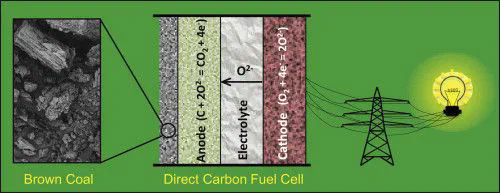Direct carbon fuel cell operation on brown coal
Feb 13, 2014·
,
,
,
,
 ·
0 min read
·
0 min read
A. C. Rady
S. Giddey
A. Kulkarni
S. P. S. Badwal
S. Bhattacharya
Prof. Dr. Bradley P. Ladewig

Abstract
The performance of a Victorian brown coal with minimal pre-treatment was assessed in a solid oxide electrolyte based direct carbon fuel cell (DCFC) at 700 and 800 °C. In order to evaluate the effect of inherent inorganic species in the coal on the electrochemical performance of DCFCs (voltage – power density – current density), characteristics of button cells fuelled with raw and acid washed (demineralised) coal were compared along with commercially available XC72 carbon black. Peak power densities of 65 and 67 mW cm−2 were observed for demineralised coal char and carbon black respectively at 800 °C, whereas the raw coal char achieved a superior power density of 89 mW cm−2. The availability of reactive species at the anode, namely CO, is believed to be the primary differentiator of cell performance, and is related to variations in the physical and chemical makeup of carbon fuels. The reactivity of these fuels in the presence of CO2 to generate CO (and power) via Boudouard gasification was assessed in the 700–800 °C temperature range via thermogravimetric analysis.
Type
Publication
Applied Energy